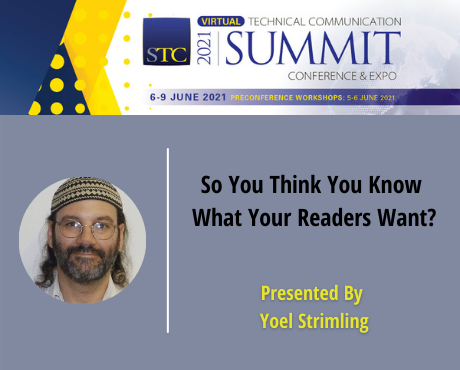You may believe you’re writing high-quality documentation—but do your readers agree?
The morning Summit session opened eyes, like a jolt of intravenous caffeine.
Yoel Strimling, the Senior Technical Editor/Documentation Quality SME at CEVA Inc., presented, “So You Think You Know What Your Readers Want?” with the passion and energy a technical writer needs to meet reader demands.
The F-Word
Strimling first addressed what he referred to as the dreaded F-word—feedback. He described two of his own studies in which he surveyed readers to see what they believed was important, and what kind of documentation was most helpful.
All writers need reader feedback if they want to provide the best quality work. Feedback should focus on issues most important to the reader and which can be acted upon by the technical writer. But, Strimling said writers should ignore feedback that isn’t meaningful and or constructive.
Quality is King
Strimling stressed the importance of defining a documentation’s quality standards. From his research, he developed a list of standards for technical writers:
- Must be from the reader’s point of view.
- Must have solid empirical backing.
- Must be clear and unequivocal.
- Must cover all possible aspects of what should be considered quality.
At its core, Strimling said, high-quality documentation must be “intrinsically good, clearly represented, contextually appropriate for the need, and accessible to the reader.”
So how does a technical writer create high-quality documents from the reader’s point of view? Think the F-word! Strimling provided specific questions a technical writer should ask readers to receive meaningful feedback:
- Was the information easy to find?
- Was the information accurate?
- Was the information easy to understand?
- Was the information relevant?
So what happens after a writer receives feedback and reader definitions of quality standards?
Strimling said, at this point, it’s time to take action:
- Find the meaningful and actionable feedback.
- Create reliable methods and metrics for measuring documentation quality.
- List common terminology.
- Help writers understand what is important to readers when feedback is unavailable.
With this information, Strimling said writers could create their own reader-oriented models for collecting useful feedback and have a starting point for every document.
About STC Summit OnDemand
For more information, and to register, visit summit.stc.org

